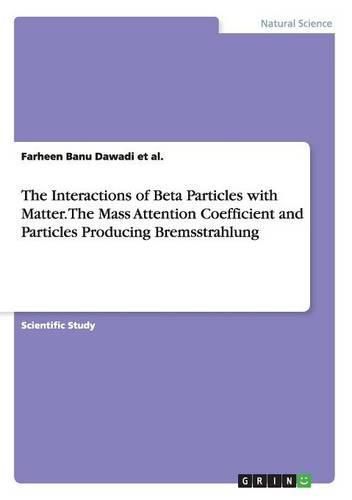Readings Newsletter
Become a Readings Member to make your shopping experience even easier.
Sign in or sign up for free!
You’re not far away from qualifying for FREE standard shipping within Australia
You’ve qualified for FREE standard shipping within Australia
The cart is loading…






Scientific Study from the year 2015 in the subject Physics - Nuclear Physics, Molecular Physics, Solid State Physics, language: English, abstract: The present paper contains the interactions of beta particles in many ways. In the first part, where the beta particles are attenuated by an absorber, I have calculated the mass attention coefficient for different materials. In the next part the beta particles producing the bremsstrahlung have been studied. It is well known that any charged particle or a neutral particles when entered into target material, loses its energy either by ionizing exciting the atom or the particle may be completely absorbed by the material’s atoms. In the present study, we have used the beta source Tl-204. These beta particles when incident on the different materials (metals or compounds) interact with the atoms of the target materials by the three processes as stated above. The beta particles are incident on the target material and depending on the decrease in the counts of the particles detected for increasing thickness of the target, the mass attenuation coefficient for the absorbing of beta particles for different materials have been found. The mass attenuation for different metals as well as for different compounds and compounds salts have been studied. By knowing the mass attenuation coefficient the linear attenuation coefficient of the corresponding metal or compound has been found. Also the dependence of mass attenuation coefficient of metals and compounds on the density of the respective metals and compounds have been successfully studied.
$9.00 standard shipping within Australia
FREE standard shipping within Australia for orders over $100.00
Express & International shipping calculated at checkout
Scientific Study from the year 2015 in the subject Physics - Nuclear Physics, Molecular Physics, Solid State Physics, language: English, abstract: The present paper contains the interactions of beta particles in many ways. In the first part, where the beta particles are attenuated by an absorber, I have calculated the mass attention coefficient for different materials. In the next part the beta particles producing the bremsstrahlung have been studied. It is well known that any charged particle or a neutral particles when entered into target material, loses its energy either by ionizing exciting the atom or the particle may be completely absorbed by the material’s atoms. In the present study, we have used the beta source Tl-204. These beta particles when incident on the different materials (metals or compounds) interact with the atoms of the target materials by the three processes as stated above. The beta particles are incident on the target material and depending on the decrease in the counts of the particles detected for increasing thickness of the target, the mass attenuation coefficient for the absorbing of beta particles for different materials have been found. The mass attenuation for different metals as well as for different compounds and compounds salts have been studied. By knowing the mass attenuation coefficient the linear attenuation coefficient of the corresponding metal or compound has been found. Also the dependence of mass attenuation coefficient of metals and compounds on the density of the respective metals and compounds have been successfully studied.